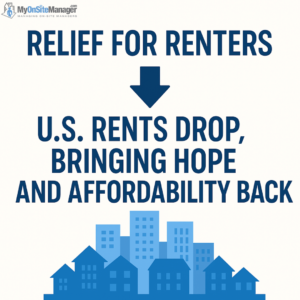After years of rising rent costs and affordability struggles, there’s finally a bright spot in the rental market rents across the U.S. are starting to ease, bringing hope to millions of renters who’ve felt the pressure of housing inflation since the pandemic.
According to a recent report from Realtor.com, the national median asking rent in April 2025 was $1,699, representing a $5 uptick from March but still $60 below the peak rent prices of August 2022. More notably, this modest increase comes at a time when household income has also been climbing, helping ease the burden for many Americans.
A Shift Toward Affordability
Realtor.com’s data revealed that the typical U.S. household now spends 23.4% of its income on rent, a welcome improvement from 24.7% in April 2024. This decline, while slight, marks a crucial shift: rental costs are aligning more closely with the standard affordability benchmark of 30% or less of household income.
In fact, 45 out of the 50 largest U.S. metropolitan areas now fall under that 30% threshold for renters with median incomes an encouraging sign that the rent burden may be gradually lifting in many areas.
What Experts Are Saying
Danielle Hale, Chief Economist at Realtor.com, highlighted the slow but steady improvement in rental affordability:
“Even in unaffordable markets, we saw improvement in April. Small but consistent declines in rent, coupled with growing incomes, are helping renters regain some financial stability.”
However, she also cautioned that rents are still 20% higher than they were before the pandemic, and many households are still adjusting to a new normal where affordability gains are incremental rather than dramatic.
Cities with the Worst and Best Affordability
Not all metro areas are benefiting equally. Miami remains the least affordable rental market in the U.S., where the cost of a typical rental exceeds affordability thresholds by 1.3x, even for households with median income. Other challenging markets include:
-
New York City
-
Los Angeles
-
Boston
-
San Diego
Still, even these cities saw modest improvements in affordability compared to a year ago.
On the flip side, Oklahoma City leads the list of affordable metros, with typical rent costs using just 55.6% of the maximum estimated affordable rent. Other cities showing strong affordability improvements include:
-
Tampa, FL
-
Denver, CO
-
Phoenix, AZ
These shifts are especially notable in the South and West, where a surge in multifamily housing supply is helping balance rental demand and pricing.
Supply and Vacancy: Why Rents Are Falling
One of the biggest drivers behind the improving rent landscape is increased housing supply. As more multifamily buildings come online, competition among landlords is growing, giving renters more options and reducing pressure on prices.
The U.S. rental vacancy rate rose to 7.1% in Q1 2025, the highest it’s been since 2018. This surplus of available units is helping prevent the steep rent hikes that defined the post-pandemic years.
What’s Next for Renters?
While it’s still too early to declare a full recovery in rental affordability, the trends are promising:
-
Rental price growth is slowing
-
Incomes are rising
-
Vacancies are up, signaling more choice and bargaining power for renters
For those who’ve felt priced out of the market in recent years, 2025 could be a turning point. That said, affordability challenges persist in high-cost cities, and renters should stay informed and proactive in their housing decisions.
Takeaways for Renters
-
Reevaluate your lease: If you’re nearing renewal, research nearby comparable listings you may find better deals.
-
Negotiate with your landlord: Higher vacancies can give you more leverage to ask for rent reductions or added amenities.
-
Track local trends: Not all markets are improving at the same rate. Check rent data in your specific metro area to make informed decisions.
-
Consider relocating: If you’re remote or flexible, cities like Oklahoma City or Tampa offer much lower rent burdens.
Read the full source article here: Relief for Renters: U.S. Rents Drop, Bringing Hope and Affordability Back!

